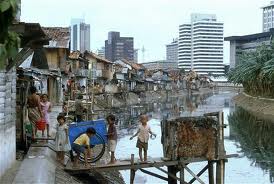In 1800, 2% of us lived in cities. By 1950 that number had grown to 30%. In 2007 we surpassed 50% and forecasts for 2050 based on present growth indicates that 65% of us will be urban dwellers.
Before World War II, the majority of humanity lived on subsistence farms supporting large family units. Today less than one-third of humanity practices subsistence agriculture. Evidence shows that as populations resettle in cities, family size decreases while average lifespan increases. Mass urbanization, therefore, is acting as a population control. As we approach 2100 cities will cause an overall slowing of the population explosion that today seems so disturbing to us.
Urbanization isn’t evenly distributed across the planet. Cities cover only 2% of the planet’s land mass but they exert a greater influence than the area of habitation. In the Developed Western World better than 90% of us live in cities. Central and Latin America are quickly approaching the same level of urbanization of North America and Europe. In Asia urban populations represent 41% of the total, and in Africa, 38%. It is in these two continents where rapid urbanization is happening.
Human Existence is Urban in the 21st Century
Our 21st century future is being shaped by cities. Half of us now live in cities and the rate of increase in city dwellers is approaching 70 million per year.
The cities of Asia and Africa like their cousins in Central and South America aspire to achieve the “American Lifestyle” of those urban communities in the Developed World. Instead so many of these fast-growing urban centres suffer from inadequate funding, poor services, congestion and the growth of informal economies that contribute nothing to the tax base necessary for funding urban improvements.
These are the urban realities of the 21st century where humanity needs to come to terms with new ways of achieving sustainability. It is in these cities that humanity will experience the bulk of urban growth . With urban migration amounting to 130 people per minute, the cities of these parts of the world face immense new challenges.
For most new migrants to cities in the first decade of the 21st century they experience urban environments like the one in the picture below. Over 1 billion urban dwellers live in what best can be described as slums although slums in the Developed World look posh compared to what is depicted here. These “homes” have little in the way of clean water, electricity or proper sanitation. Most of the inhabitants work at jobs in what is coined the “informal economy.”
The informal economy is huge. Estimates put it at $10 trillion per year, bigger than the economy of Japan. But it is an economy that is underground, driven by barter and cash. It makes no tax contribution to the cities in which it operates. As a result the cities have inadequate funding to provide improved services and materials to the newcomers who desperately need what the city potentially can offer.

A good example of this dynamic can be found in Lagos, Nigeria. A slum there, called Makoko, is home to rural fisherman who have migrated to pursue the dream of a better life. The inhabitants find jobs wherever they can, develop home-based business ventures, barter for food and material goods, contribute to the survival of their families but have no economic relationship with Lagos itself. These new immigrants don’t own the land where they have erected their shacks and pay no taxes. Makoko is like many African urban slums. Its people are disenfranchised with no property they can call their own. They have limited city services. Almost everything of use is found by residents foraging for materials, and finding sources of power and water when and wherever possible. Although many have televisions and “Western” material things in their homes, the homes themselves are knocked together with tin and scrap wood. And should the Government of Nigeria choose to build something in Makoko these homes get bulldozed with the tenants having no legal title or recourse.
Lagos is the fastest growing city in Africa. Makoko represents one of its many enormous challenges. At its current growth rate of 8% per year, Lagos will exceed 25 million in population by 2015. Two-thirds of its inhabitants will reside in Makoko-like shanty towns. In 2015 Lagos will become the 3rd largest city in the world, only surpassed by Tokyo, Japan with its well-developed infrastructure, and Mumbai, India, suffering from many of the same challenges as Lagos.
Urban Sustainability in the Developing World
How do you plan for cities that grow at 8% per year? When informal settlements mushroom into existence almost overnight and usually within proximity of the commercial centres of these cities, what can planners do to deal with these new facts on the ground?
Today 1 billion people live in urban slums. Total new annual housing requirements equal 35 million units per year, 96,000 per day, 4,000 an hour, or 66 per minute. The United Nations Population Fund, an international body focused on the challenges of population growth in cities is seeking international cooperation to develop innovative housing policies. One idea changes informal settlements, such as the one depicted in Jakarta, into planned communities where new immigrants have significant input. The idea is to encourage new immigrants to build permanent homes by providing simple, easy-to-construct plans along with appropriate building materials. House designs would allow for family expansion. Instead of horizontal growth, houses would grow vertically allowing families to safely add 2nd and 3rd floors over time. This would address the need for urban intensification without building of high-rise concrete towers. It would also allow families to operate informal businesses from their homes, a reflection of the cultural characteristics of newcomers and the informal economy in which they operate.
Another idea comes from Venezuela where squatter settlements around the capital city, Caracas, are undergoing transformation. Instead of demolishing these shanty towns and moving the inhabitants to high-rises, urban planners are surveying the settlements and providing those living in the area with title to the property they occupy. Pride of ownership can work magic even in an impoverished community. This policy is leading to the formalizing of these suburbs and their integration into the larger urban community including the provisioning of city services.
Venezuela is also experimenting with novel building materials to meet its growing demand for new housing. Because the country has abundant oil reserves, it is manufacturing homes from the output of refineries and even exporting these simple, modular plastic homes to other Developing World countries like Cuba.

For the people of Lagos and other Developing World cities, experiments in policy such as those described above could prove to be powerful new methods for changing the urban environment. After all, Nigeria and Venezuela share the same challenges and both have abundant oil reserves.
We’ll continue this topic in our next blog when we look at how cities in both the Developed and Developing World are deploying new ideas and 21st century technology to address the other challenges cities face — pollution and waste, energy production and conservation, dealing with water and urban food requirements, developing new transportation solutions, and building an urban model that achieves a healthier, biodiverse-rich future.







